Life with the Lenovo Yoga 2 Pro
by Brett Howse on July 30, 2014 2:00 PM EST- Posted in
- Notebooks
- Lenovo
- Windows 8.1
- Yoga
High DPI display
I was rather impressed by the display on the Yoga 2 Pro. The 13.3” IPS touchscreen at 3200x1800 gives the Yoga 2 Pro one of the highest pixels per inch of any current Windows 8.1 device at 276 PPI. Running desktop applications at 3200x1800 can cause some issues, and if so the only solution at this time is to drop the resolution down to 1600x900. It usually depends on the application itself and whether it supports a HiDPI mode. Some play nice and some do not. As one might expect, in a modern application environment the high DPI brings crisp font rendering and a sense of clear graphics.
Application issues aside, all is not perfect with this display either. As we know from past reviews, high PPI devices can have a higher battery draw because the amount of backlight required to push the same amount of light through a dense display is simply higher. One solution to this problem is a Thin-Film-Transistor (TFT) made of Indium Gallium Zinc Oxide (IGZO), which can be thinner than the amorphous silicon of a standard TFT and offers better transparency than the standard TFT. Some devices (like the Razer Blade which is also 3200x1800) have chosen this method. Unfortunately, likely for cost reasons, the Yoga 2 Pro has chosen to go with an RGBW pentile pixel arrangement. The white subpixel is used to improve the brightness of the display without having to overpower the backlight, but it comes with a cost of color reproduction and contrast ratio. The early runs of the Yoga 2 Pro suffered from very bad yellows. Since the initial release, Lenovo has updated the device firmware and software to help compensate.
Out of the box image quality
With the white pixel, one of the biggest things to suffer is the contrast ratio. The maximum brightness of the screen is not very high to begin with, with 249 nits at 100% brightness. At that level of backlight, the black level is 0.5 nits, giving a meager 497:1 contrast. The brightness levels are fine for indoor use, but with blacks that bright it really hurts contrast and can be pretty noticeable when using this laptop.
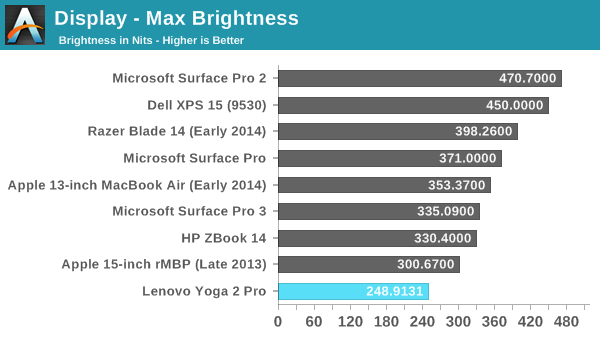
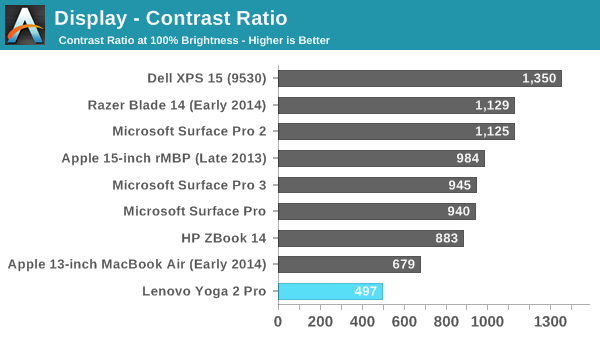
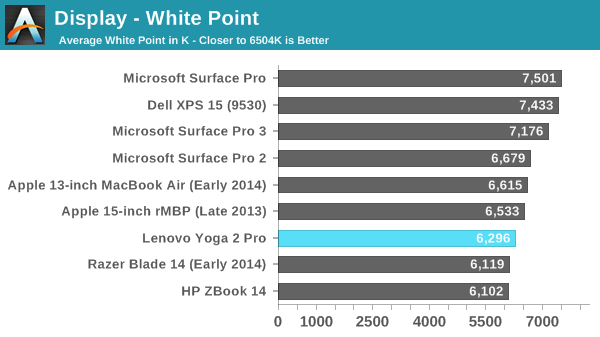
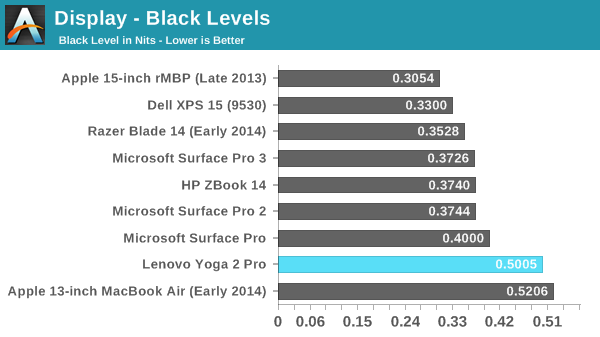
Contrast ratios aside, other elements of the display are pretty good for a consumer focused laptop. Out of the box, the greyscale DeltaE is an impressive 1.417. Blues are a bit low in the overall score, but only a bit.
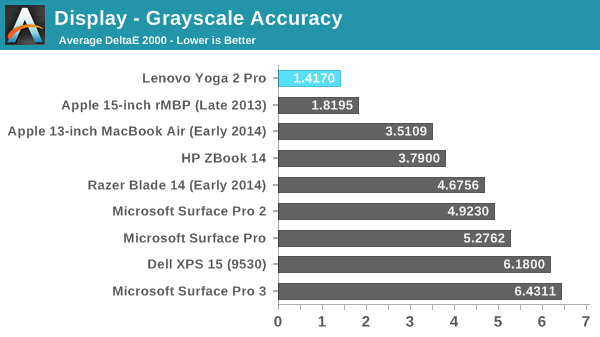
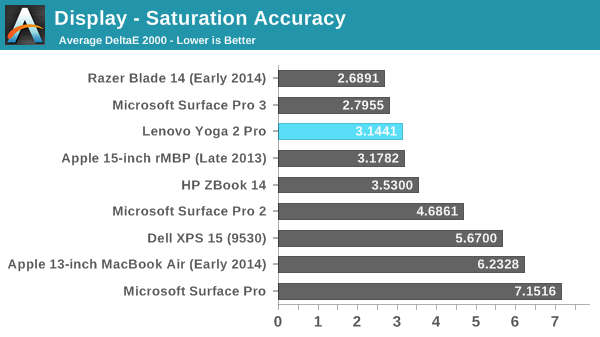
The uncalibrated saturation is also decent at 3.1441. There is definitely some drift, but it is not terrible. The yellows are spot on for saturation, which is a good sign after the firmware and software fixes to correct that. Cyan and Magenta are off, which is a theme going forward.
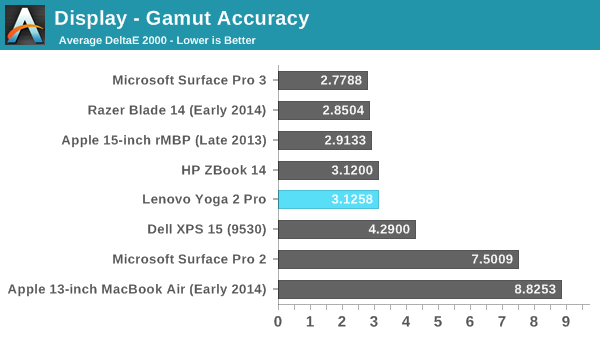
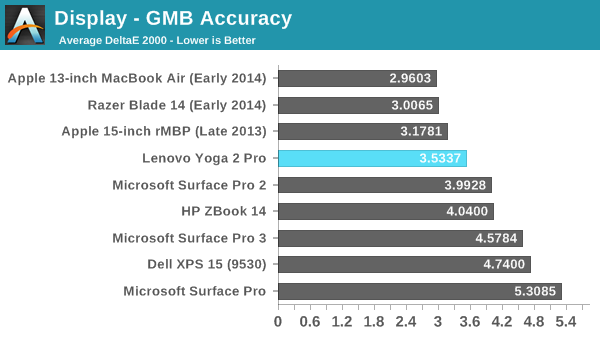
For the Gretag Macbeth colorchecker, we once again have a reasonable result of 3.5337. This device is not going to be suited for a professional image editor, but it is not really marketed as a professional device. We are looking for values under three, and the Yoga 2 Pro is close.
Calibrated image quality
Next up we will take a look at the display after it has been calibrated.
Once calibrated, the already great greyscale gets even better, with a DeltaE 2000 of 0.7834 and a white point of 6570, but that excellent result does not carry over to the rest of the display’s abilities. Cyan is again our biggest culprit, with it having a DeltaE of around 7 when the display is calibrated. This actually pulls the GMB score higher than the stock settings.
Display conclusion
Just looking at the device specifications, this should be a great display with such a high resolution. But the pentile nature of the screen can and does cause havoc with both blacks and colors. Unfortunately this display is just OK. If it was compared against most laptop panels of only a year or two ago, it would likely be a standout with both IPS and high resolution, but unfortunately it falls somewhat short. The color accuracy is not ridiculous (at least patched) but the contrast ratio really hurts, and as someone who really prefers black levels very low, it is very noticable how much light gets through on dark content. However to be fair, the redeeming quality of the display is the QHD+ resolution and to achieve that at the price point Lenovo wanted they chose to go with RGBW. It’s a compromise, but one that really does deliver on the crispness of text and images.


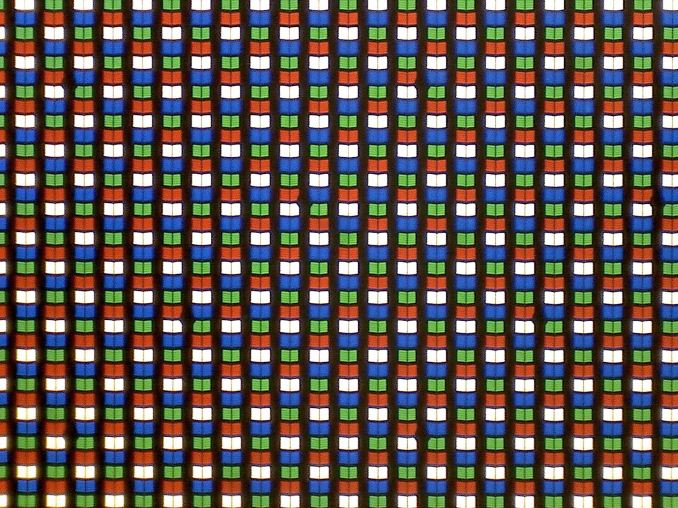
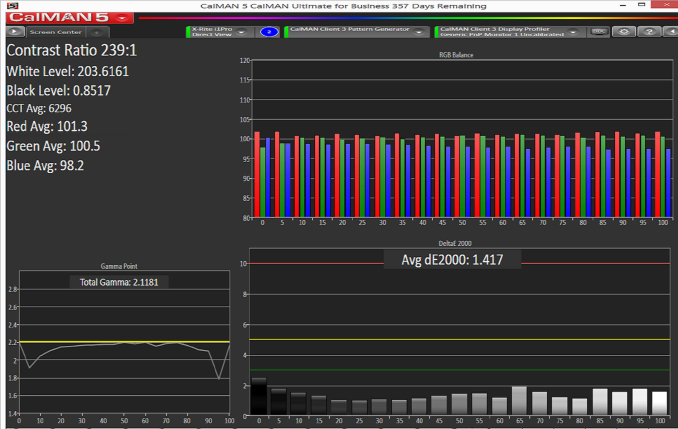





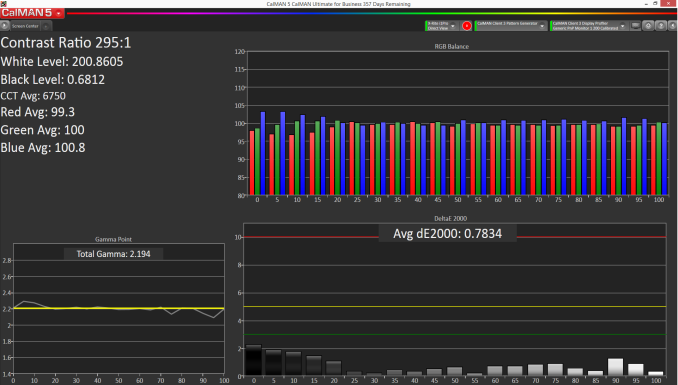











103 Comments
View All Comments
SanX - Friday, August 8, 2014 - link
What is actually very BAD and no one noticed- Crazy 97C temperature of processor cores. Intel must speed up its 14nm technology
- Because matrix is pentile its PPI=195 or may be a bit better due to RGBW. This makes this screen actually even worse then in Microsoft Surface 3 PPI=216. You can see all its gargantuan pixels on both. How tech people are sooooooo damn fooled by the fake 3200 numbers? Large tablet screens ***must be 4K***
Rdmkr - Sunday, August 10, 2014 - link
your PPI math is off; the number of subpixels matches that of a 225 PPI 13.3 inch non-pentile screen. I thought pentile was a disaster until I learned that the human eye almost completely ignores color information in registering pixel-level detail. The wikipedia page for "Chrominance" has a good picture to demonstrate this, as does the one for the "YCbCr" color space. Another piece of evidence towards this is that blue-ray content has heavily undersampled color information and hardly anyone ever notices or mentions that it is less than "true" 1080p.mitchellvii - Tuesday, September 9, 2014 - link
Sorry dude but I've owned both the Surface Pro and the Y2P and I'm here to tell you, the Surface Pro comes nowhere close to the clarity of this screen. You honestly have no idea what you are talking about.mitchellvii - Tuesday, September 9, 2014 - link
97C? Lol, really? My Y2P i7 rarely even gets warm. I could bake bread on my Surface Pro.Bateluer - Sunday, August 10, 2014 - link
I almost bought this same model a few weeks back, but ended up going for the older 11s model instead. The Yoga 2s were definitely nice, but that un-upgradeable RAM is a real buzz kill.medi02 - Monday, August 11, 2014 - link
I wish they'd do it with one of AMD's APUs. The one with discrete GPU is way to expensive and Intel HD is a no thanks, not to mention the higher price.petwho - Monday, August 11, 2014 - link
I bought a Lenovo laptop last year. But its performance was so slow that I decided never come back with this brand.venkman - Monday, August 18, 2014 - link
Good write up. I bought a Y2P in November 2013 and pretty much agree with everything you said here. Thankfully the yellow issue was resolved with a firmware update because I was about to take the dang thing back just for that. Other than that, the WiFi is a joke and a lot of people on the lenovo and notebookreview forums have taken to manually upgrading the wifi cards themselves. The screen resolution is nice but completely unnecessary considering the impact it has on battery life. Not many programs fully support it anyways. I feel like Lenovo got some kind of crazy deal from their supplier on these 1800p screens that actually saved them money by going this route instead of a 1080p screen. Other than that, I love my Y2P and I fly with it regularly. It is a dream in cramped economy with tablet and tent mode. Flight attendants ask my GF to put her Macbook Air (which I believe weighs less) away when the door closes but never bother me with my Y2P in tablet mode.mitchellvii - Tuesday, September 9, 2014 - link
If you want deeper blacks, just turn down the gamma. Everyone knows that. Geesh. Blacks on my unit with gamma at .5 are as inky as on a super amoled display.mitchellvii - Tuesday, September 9, 2014 - link
You blame the Y2P for having poor black levels when the fact is YOU are the one with NO clue how too adjust black levels on a PC. It's called "Gamma" and it's in the HD Control Panel. Honestly, if you are going to be a reviewer, please get some rudimentary computer knowledge.